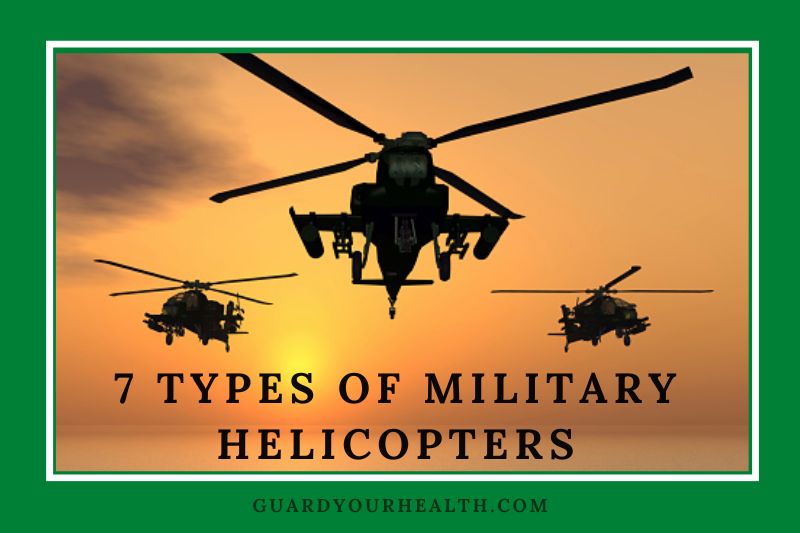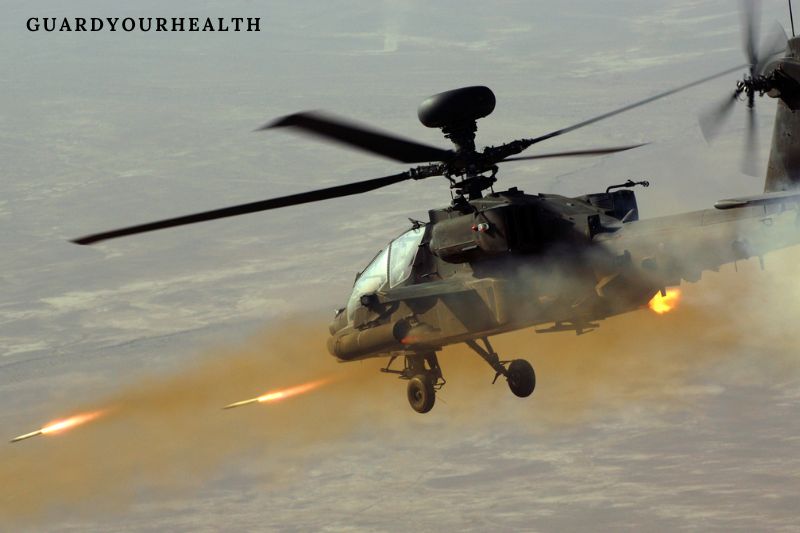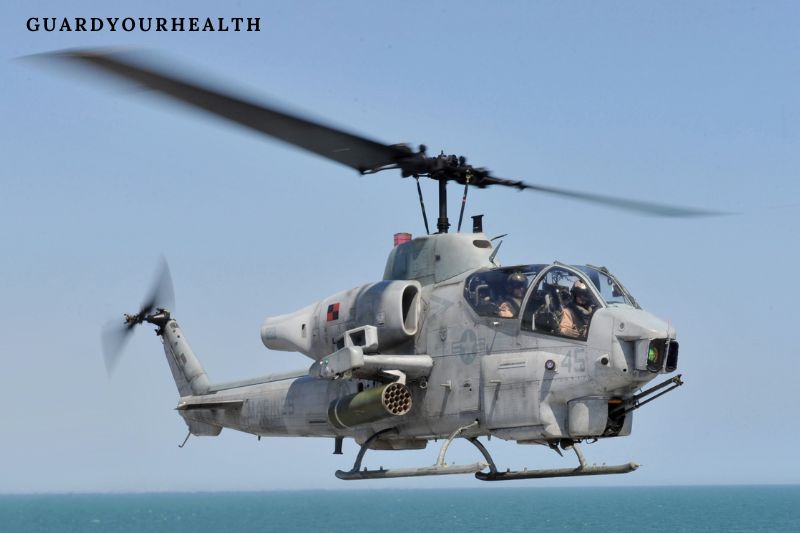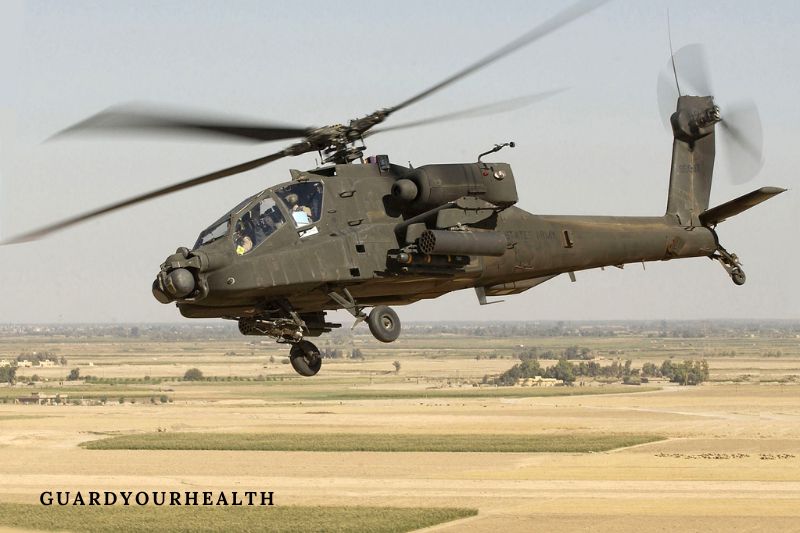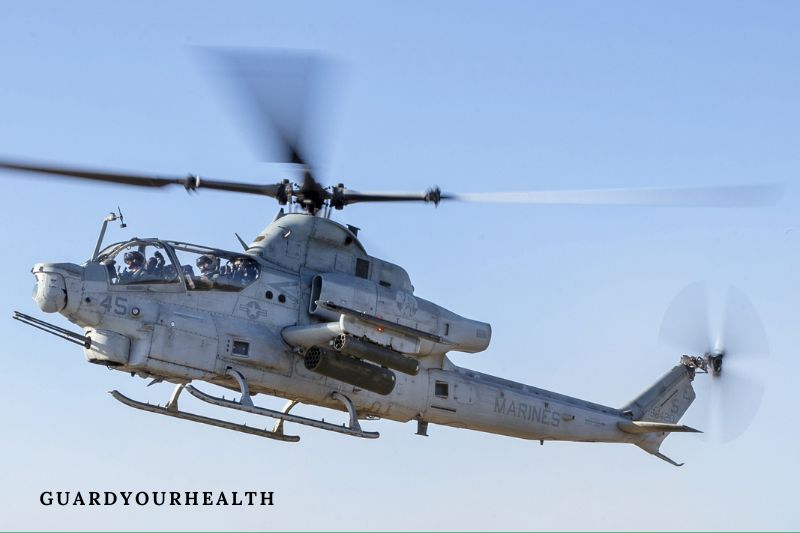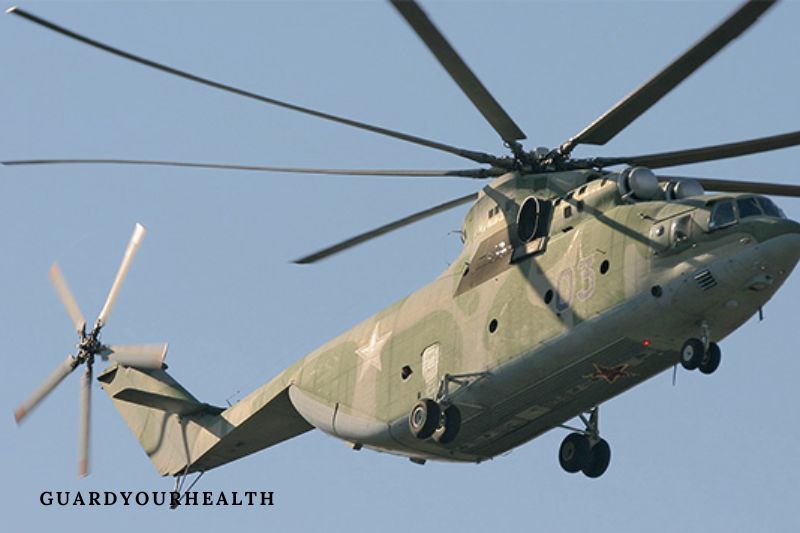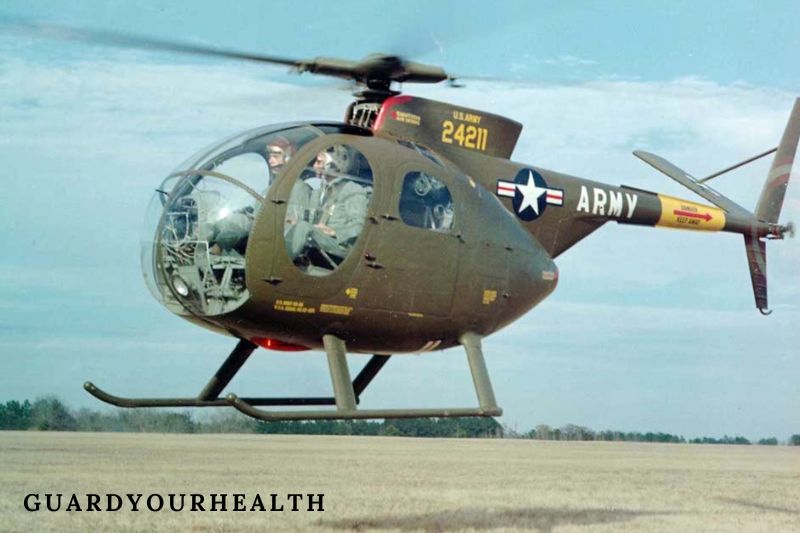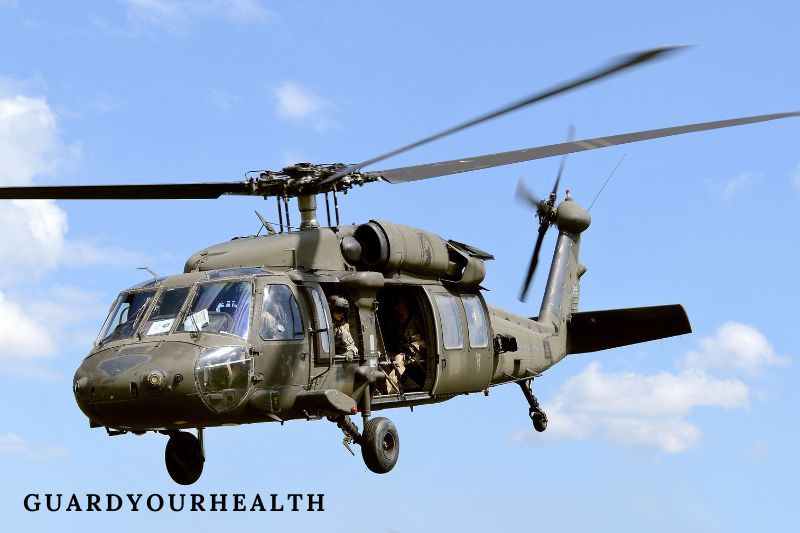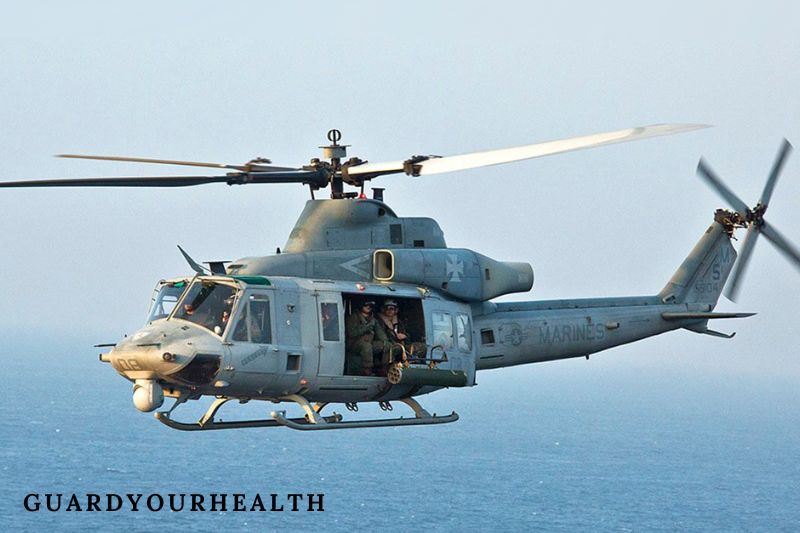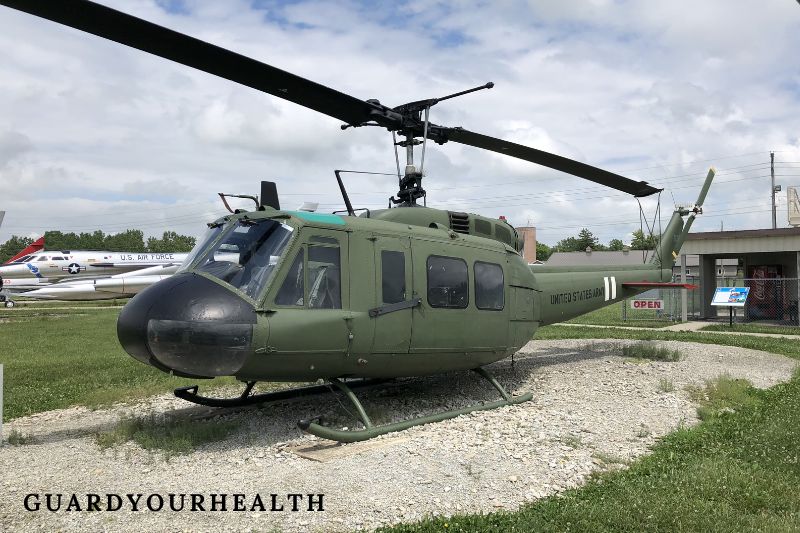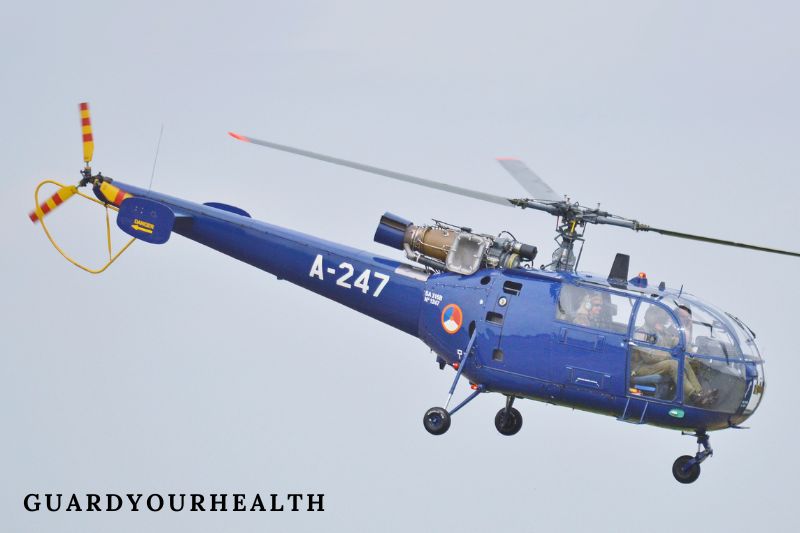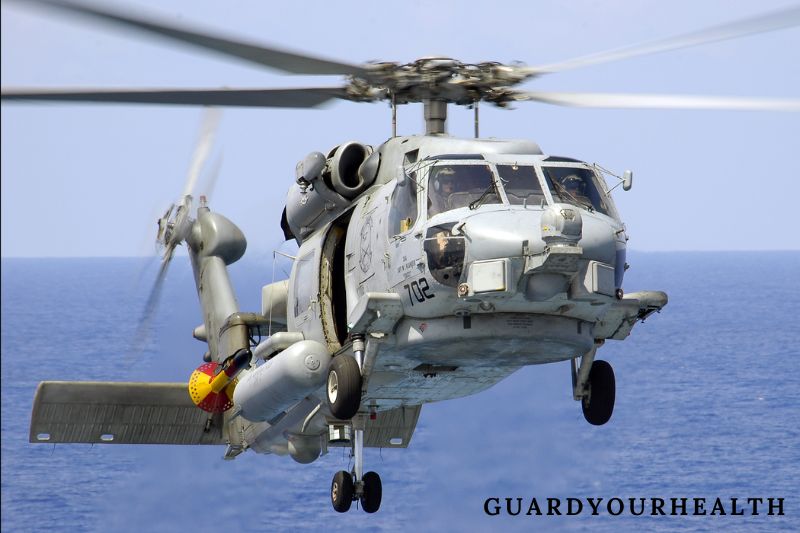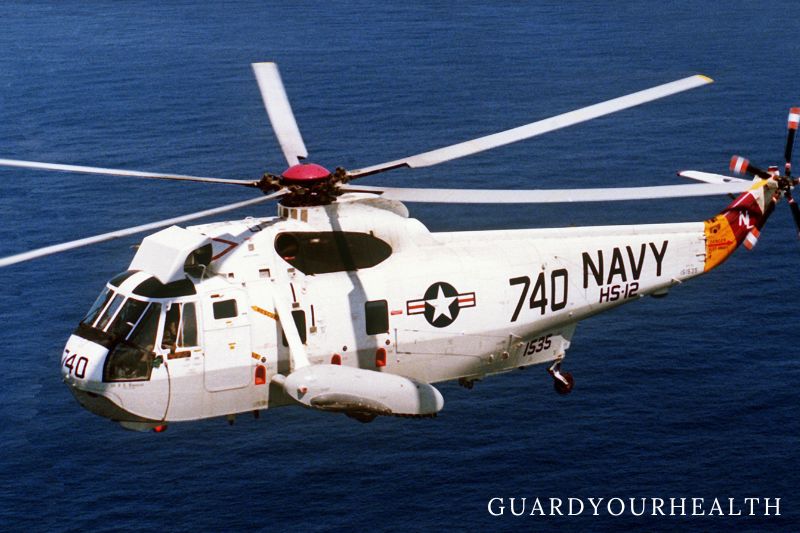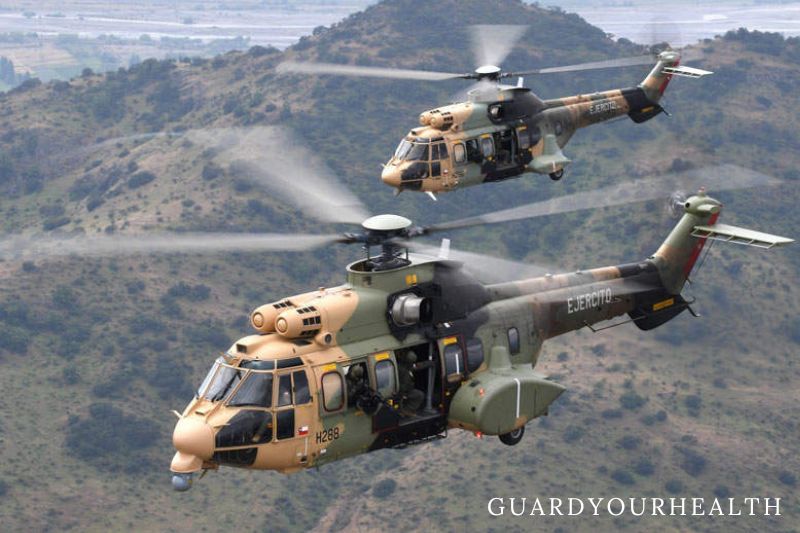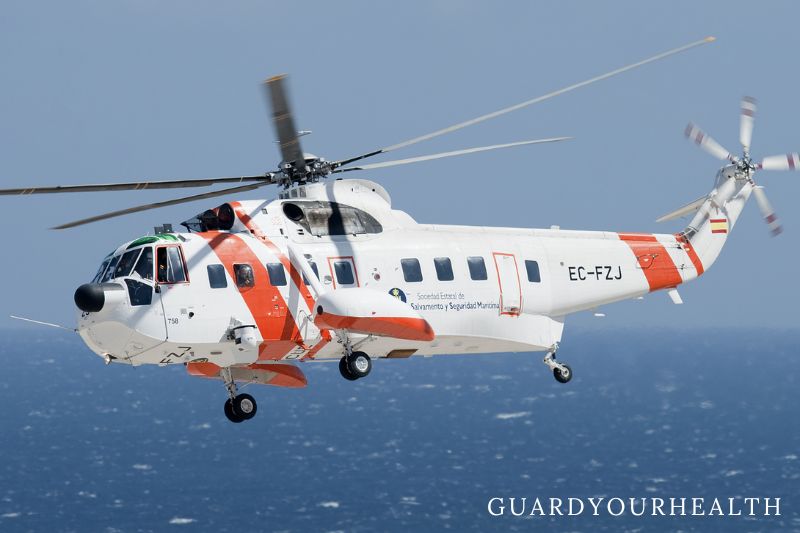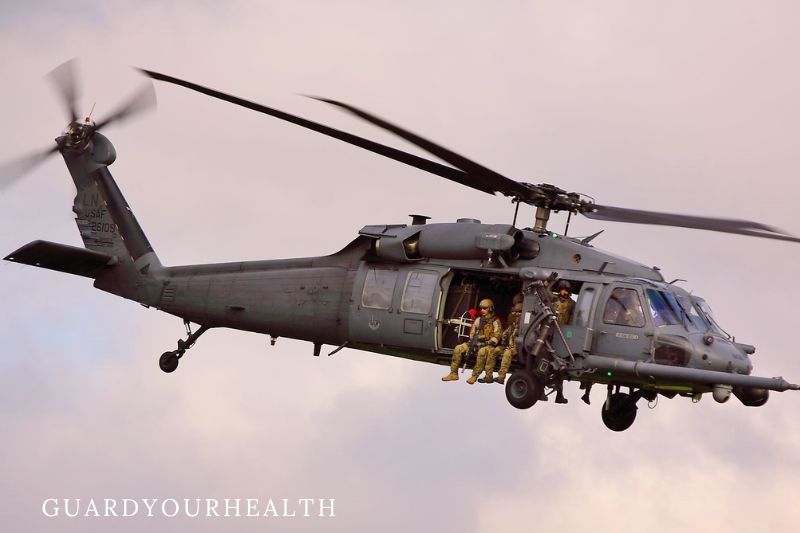There are many different types of helicopters around the world today. Some are designed for transport, others for the attack. Some are small and agile, while others are large and heavily armed. Whatever their purpose, all military helicopters share some common features, such as the ability to fly in all weather conditions and to land and take off in relatively small spaces.
In this blog, GuardYourHealth will explore the different types of military helicopters and their uses.
7 Types of Military Helicopters
1. Military Attack Helicopters
The primary function of attack helicopters, sometimes known as helicopter gunships, is to fire on the adversary. Attack helicopters are capable of reaching high speeds and are well-armed with a variety of armaments such as machine guns, missiles, and auto-cannons.
The assault helicopter armory, which is equipped with superior radar for recognizing enemy targets and directing bullets, is used to successfully destroy enemy armed tanks and vehicles. The assault helicopter exists to provide air support for ground forces and other aircraft.
Attack Helicopter Examples
AH-1W Super Cobra
The main assault helicopter of the Marine Corps is the AH-1W Super Cobra. The Bell Helicopter AH-1W Super Cobra is an assault helicopter based on the Huey design. The Super Cobra was the first attack helicopter to qualify for both the sidearm anti-radiation missile and the sidewinder air-to-air missile—it can also handle hellfire missiles.
The Super Cobra has been in service since 1967 and was deployed to Operation Iraqi Freedom in 2003. The Super Cobra serves as the principal attack helicopter for the USMC air-ground task force, providing ground cover or escorting additional air support.
The Marine Corps has operated the Super Cobra since 1986, with the last of these helicopters deployed in 1998. The AH-1W Super Cobra succeeded the AH-1 Cobra, while the AH-1Z Viper replaced the Super Cobra. The Viper is set to replace the final Super Cobra in 2020.
Bell AH-1G Cobra
The Bell Helicopter Textron Bell AH-1G Cobra first flew in 1965. It was the world’s first and served the U.S. military until 2001. Here’s how it appears:
It has a single engine and is also known as the HueyCobra or the Snake because it is a member of the Huey helicopter family.
Boeing AH-64 Apache
Following the purchase of Hughes Helicopters, Boeing produced this. It took its initial flight in 1975, although it was not formally unveiled until 1984. The Boeing AH-64 Apache is still in service today.
Aside from the U.S. military, this helicopter is utilized by the air forces of Egypt, Israel, and the Netherlands. It is typical.
- Airspeed: 365 kph or 227 mph
Bell AH-1Z Viper
This Bell-built helicopter first took to the skies in 2000. It was initially introduced in 2010 and is still used by the military’s helicopter crew.
Mil Mi-24 (Hind)
The Mil Mi-24 is one example outside of the U.S. military (Hind). It is used by the Russian Air Force. Mil Mi-24 (Hind) was introduced in 1972 by Mil Helicopter Plant. It is armored and equipped with auto-cannons (twin-barrel), machine guns, rocket and missile launchers, and other weapons.
2. Military Transport Helicopters
Transport helicopters are among the largest helicopters and are used to transport heavy cargoes such as light vehicles, large groups of personnel, and supplies into combat zones. Despite their size and load, cargo helicopters can travel at a rather fast speed.
Though cargo planes may perform the same role as transport helicopters, the helicopter is great for its ability to land and take off vertically with no runway—speed is crucial in wartime operations. Transport helicopters also carry specialist equipment such as rescue hoists and rope lines for dropping down and picking up personnel in tough terrain.
Transport Helicopters Examples
The Chinook is the most well-known cargo helicopter. The Boeing CH-47 Chinook is a twin-engine helicopter known for its tandem rotors. The Chinook is one of the most powerful Western helicopters, serving as the principal supply and troop transport helicopter for the United States Army.
Boeing began designing the Chinook in 1956, and it was initially deployed in Vietnam in 1962. The Chinook has been updated several times since the Vietnam War and is not slated to be retired until 2060 when it will become the Army’s first 100-year longevity aircraft.
The Block 2 Chinook is the second generation of the Chinook and comprises both the CH-47 F-model and the CH-47 G-model. Despite the Block 2 Chinook’s technologically upgraded capabilities, the U.S. Army declared that as of Fiscal Year 20, it will no longer order the new CH-47F and will instead purchase the 69 G-model Chinooks due to being manufactured. The Chinook G-model is the special operations variant.
The Super Stallion is another important transport helicopter, well-known for its involvement in peacekeeping and international affairs. The Sikorsky CH-53E Super Stallion is the largest heavy-lift transport helicopter used by the U.S. military. The Super Stallion was created for usage by the Marine Corps. This helicopter has a seven-bladed main rotor and can transport up to 73.5K pounds of cargo.
The US Marine Corps (USMC) has utilized the Super Stallion since the 1980s and plans to continue using it until at least 2025. During the late- and post-Vietnam War era, the Air Force used an early form of the Super Stallion, the HH-53 Super Jolly Green Giant—the Super Stallion is an enhanced version of the HH-53.
Today, the CH-53E Super Stallion is used by several countries and participates in various international military exercises, including the world’s largest multinational maritime training exercise. This helicopter has significantly enhanced international relations, as well as global sea passage and ocean security.
3. Military Observation Helicopters
Sensor and communication devices help intelligence collection and reconnaissance tasks aboard observation helicopters. These helicopters are outfitted with sensor suites, communications equipment, infrared cameras, low-light television, and laser systems for observing and identifying targets. Targeting activities performed by observation helicopters include guiding anti-tank missiles and directing air attacks.
The Little Bird is an observation helicopter that is crucial to military operations and has been made popular in modern movies. The McDonnell Douglas MH-6 Little Bird, nicknamed “the killer egg,” is an unmanned surveillance helicopter. The Little Bird has main fuel tanks that are impervious to small arms fire and the option to install auxiliary fuel tanks for enhanced range. Unlike many military aircraft, the Little Bird can be quickly deconstructed, making it ideal for air transportation.
The Little Bird has several modern digital cockpit systems, including navigation, sensor, night vision, and control units. There are several variations of the Little Bird, notably the MH-6M, which has been significantly upgraded with avionics and fitted specialist equipment and weapons system requirements.
Originally intended for reconnaissance, the Little Bird was proven most successful in warfare in the 1980s. Today, the Little Bird is almost exclusively used by the United States Army’s elite 160th Special Operations Aviation Regiment to deposit personnel, or “night stalkers,” into tight locations or on rooftops. The Little Bird was further popularized by the book and film “Black Hawk Down,” in which the planes were portrayed delivering Delta Force soldiers.
The Kiowa is another stealth reconnaissance helicopter that is frequently used by military units all over the world. The Bell Helicopter OH-58 Kiowa Warrior is a four-bladed, single-engine reconnaissance helicopter with sophisticated weaponry, navigation, avionics, communication, and cockpit integration systems that enable day and night operations in severe weather and standoff ranges. The Kiowa is primarily used by the United States Army as a target, light assault, and defensive air combat mission helicopter. The Kiowa is easily deployed and fully operational within minutes of arrival.
Since the first Kiowa was delivered to the Army in 1969, it has served in several wars across multiple service branches, including the Vietnam War, Operation Prime Chance with the U.S. Navy, RAID with the Army National Guard, and the post-2001 Iraq and Afghanistan wars. The Aviation Restructure Initiative led to the U.S. Army selling around 300 Kiowa helicopters through foreign military sales in 2013.
4. Military Utility Helicopters
Examples of Military Utility Helicopters
Sikorsky UH-60 Black Hawk
Sikorsky’s UH-60 Black Hawk is a medium-lift, twin-engine, four-bladed utility helicopter. The Black Hawk is a tactical transport helicopter and air assault aircraft used by the United States Army. The Black Hawk has a dragging tail wheel landing gear configuration. This military helicopter can fly in any weather. The Black Hawk may be outfitted with landing skis in frigid conditions.
The Army initially used the Black Hawk in 1978 after Sikorsky’s UH-60 Black Hawk design won the United States Army Utility Tactical Transport Aircraft System (UTTAS) competition in 1976. Today, the United States military operates over 2,000 UH-60 Black Hawk helicopter versions. The UH-60 Blackhawk was popularized by the 2001 film “Black Hawk Down.”
Originally, Army Regulation 70-28 mandated that helicopters be named after Native American tribes. The regulation no longer exists, but the practice lives on, and the Bureau of Indian Affairs is engaged in the naming of new helicopters. The UH-60 Black Hawk was named after Native American War Leader Black Hawk.
UH-1Y Venom
The utility helicopter “UH-1Y Venom” is notable for its toughness. Bell Helicopter’s UH-1Y Venom is a new Marine Corps utility helicopter that will replace the Huey. The Venom is also known as “Super Huey” and “Yankee,” from the phonetic pronunciation of its variant letter “Y.” This helicopter entered service in 2008, replacing the Marine Corps’ inventory of UH-1N Twin Huey aircraft.
This military aircraft has two turboshaft engines and a four-bladed, ballistic-tolerant, all-composite rotor system. The Super Huey is an armed aircraft with increased survivability and cargo carrying capacity, as well as a 50% improvement in speed and range. The Super Huey is used for command, control, and attack support during the day, night, and in inclement weather.
Bell Helicopter UH-1 Iroquois
The Iroquois, sometimes known as the Huey, is a vintage utility helicopter. The Bell Helicopter UH-1 Iroquis, nicknamed “the Huey,” is a single-engine, light-lift utility helicopter with two-bladed main and tail rotors. The Huey was created in 1952 to meet U.S. Army medical evacuation requirements. The Huey was the first turbine-powered helicopter produced by the U.S. military in 1960.
The Huey, which can fly during the day and at night, was originally used as a combat-zone troop transport helicopter in Vietnam. The UH-1N Iroquois was added to the Air Force aircraft inventory in 1970 for its search and rescue capacity. Today, over 16,000 of these military helicopters have been produced globally, and the Huey is used to support a broad range of tasks, including DEA counter-narcotics operations in Afghanistan.
Aérospatiale Alouette III
NHIndustries NH90
This is a medium-sized utility helicopter. It was released in 2007. Therefore it is considered quite new. It has multi-mission capability and is used by European, Middle Eastern, and Australian air and naval forces. This is what it looks like:
5. Military Maritime Helicopters
Maritime helicopters are modern aircraft with improved electronics and weaponry systems. These helicopters were designed to serve numerous U.S. Navy operations such as search and rescue and reconnaissance, but their primary purpose was anti-submarine warfare and weapon delivery, including air-launched torpedoes.
Examples of Maritime Helicopters
Sikorsky SH-60 or MH-60 Sea Hawk
Sikorsky Aircraft Corporation built this helicopter. It was introduced in 1984 as a version of the Sikorsky UH-60 Black Hawk. It dutifully served in the U.S. Navy and other countries’ navies, including Australia, Spain, and Turkey. This is what it looks like:
- Airspeed: 330 kph (210 mph).
- Capacity: 5 soldiers
AgustaWestland AW101
This is a medium-lift helicopter produced by the United Kingdom and Italy. It debuted in 1999 and is now used by the Royal Navy, the Italian Navy, and the Danish Air Force. It can do a variety of tasks due to its multi-mission capacity. Here’s how it appears:
- Airspeed: 309 kph (192 mph).
- Capacity: 26-45 soldiers
Sikorsky SH-3 Sea King
As the name implies, this is a major anti-submarine warfare player in the United States Navy. It can also perform well in other multi-role processes.
- Airspeed: 219 km/h (136 mph)
- Capacity: 26 soldiers
6. Military Multi-Role Helicopters
Multi-role helicopters are flexible types of helicopters that support a wide range of tasks across military branches. During the rescue, medivac, and recovery operations, these helicopters are used when harsh situations and challenging terrain prevail.
The Apache is a multi-role helicopter known for its two rotors. The Boeing AH-64 Apache is a twin-engine, multi-mission, heavy category attack helicopter with two four-bladed rotors (one main and one tail). The Apache is used by the Army for a precise strike and armed reconnaissance missions during the day, night, and in all weather conditions. The Apache has sophisticated navigation, avionics, onboard sensor suites, and system redundancy, which improves survivability and lethality in warfare.
The Apache has several distinguishing features, such as shielding between cockpits, which promotes the survival of one or more crew members if the aircraft is hit, and the Integrated Helmet and Display Sighting System (IHADSS), in which the automatic M230 Chain Gun can be mounted to the pilot’s or gunner’s helmet and pointed in the direction they look.
This helicopter also includes a nose-mounted sensor suite for night-vision systems and target acquisition, four hardpoints loaded with a combination of Hydra 70 rocket pods and AGM-114 Hellfire missiles, and is armed with a 30 mm (1.18 in) M230 Chain Gun. Since its inception in 1984, the U.S. Army Apache fleet has logged over 3.9 million flying hours.
The Lakota, a multi-purpose helicopter primarily used in Army training, is replacing the Black Hawk. The Eurocopter UH-72A Lakota is a twin-engine, single four-bladed main rotor, single two-bladed tail rotor, the light-duty helicopter used by the United States Army National Guard. The tail rotor is enclosed, allowing for secure freight loading and unloading.
The Lakota is an unarmed, light-duty utility helicopter that is mostly used as a medivac helicopter. In 2006, the U.S. Army National Training Center in Fort Irwin, California, began using the Lakota to relieve the Black Hawk helicopters that were previously deployed there for medivac missions.
The Coast Guard’s favorite multi-role helicopter is the Jayhawk. Sikorsky’s MH-60 Jayhawk is a two-engine, medium-range, multi-mission helicopter based on the Army’s Black Hawk helicopter.
The U.S. Coast Guard uses the Jayhawk for all-weather search and rescue, marine environmental protection, military preparedness, law enforcement, and maritime drug interdiction missions. Notably, the Jayhawk has deployed in support of Operation Desert Storm, Operation Enduring Freedom, Alaskan hiker rescues, and Hurricane Sandy offshore rescues.
The Jayhawk debuted in 1990, replacing the now-retired Pelican. The Jayhawk is available in two variants: the HH-60J and the MH-60T, both of which are multi-range rescue helicopters. The USCG air fleet consists of 42 MH-60 Jayhawks, the majority of which are operating and several of which have been modified to the MH-60T since 2008.
The Osprey is another remarkable multi-purpose helicopter that is used by special operations in war zones. Boeing’s V-22 Osprey is a multi-role combat aircraft. The Osprey is unique in that it takes off and lands like a helicopter, but it turns into a turbo-prop airplane during flight thanks to the chopper’s tilt-rotor technology.
The US Marine Corps and the U.S. Air Force both use Osprey variants for special operations missions. With its one-of-a-kind capabilities, the Osprey has been used in medivac and transport operations in conflict zones around the Middle East.
Finally, the Sea King is one of the most renowned multi-purpose helicopters due to its active involvement in delivering the President of the United States. The Sikorsky SH-3 Sea King is a twin-engine helicopter with a boat-like structure on pontoons with floating bags that allows it to land on water.
The Sea King was the world’s first amphibious helicopter and the first of its kind used by the United States military. The U.S. Navy primarily used the Sea King for anti-submarine warfare.
The Sea King was a vital anti-submarine warfare capability for the United States Navy from its inception in 1961 until its replacement in the 1990s. More than 52 years after its maiden flight, the Sea King is no longer in production, but it still serves Marine One, which transports the President of the United States.
7. Military Search and Rescue Helicopters
The last sort of aircraft we’ll look at today are searching and rescue helicopters. These helicopters are nimble and sturdy aircraft capable of handling all terrain and weather situations. This aircraft’s primary mission is to locate, rescue, and retrieve people in dangerous circumstances. To do this, search and rescue helicopters are outfitted with cutting-edge avionics and radar systems.
The Dolphin is the primary search and rescue helicopter of the Coast Guard. The Eurocopter MH-65 Dolphin is a two-engine, short-range recovery helicopter that is immediately recognizable as a U.S. Coast Guard helicopter owing to its orange hue. The Dolphin runs day and night and in all weather situations except ice.
The Dolphin was added to the U.S. Coast Guard inventory in 1984. The Coast Guard’s aviation fleet has 100 Dolphins. The Dolphin is now the Coast Guard’s primary search and rescue helicopter. This helicopter is projected to be in service until 2027.
The MH-65 recently received extensive modifications, including the replacement of old components and the enhancement of the communications package as part of a conversion-sustainability project. Notably, the Coast Guard’s Dolphin fleet has received engine modifications since 2007, offering 40 percent more aerial use of force and power capabilities.
Examples of Search and Rescue Helicopters
1. Sikorsky MH-60G or Sikorsky HH-60G Pave Hawk
This is a search-and-rescue helicopter currently in use by the United States Air Force and the South Korean Air Force. It is comparable to the UH-60 Black Hawk but has its own avionics systems. It can work at any time of day or night and in any weather.
- Airspeed: 294 kph (183 mph).
- Capacity: 12 soldiers
2. Sikorsky S-61R
Another Sikorsky search and rescue helicopter. It was first used by the United States Air Force and Coast Guard in 1961. It is also used by the Tunisian Air Force, in addition to the United States.
- Airspeed: 295 kph (165 mph).
- Capacity: 28 soldiers
FAQs
1. What are the big US army helicopters called?
The CH-53E Super Stallion, manufactured by Sikorsky, is the largest heavy-lift transport helicopter utilized by the U.S. military. The Super Stallion was designed for use by the Marine Corps.
2. What kind of helicopters does the Air Force use?
The Air Force uses several helicopters, including the V-22 Osprey, the HH-60 Pavehawk, and the venerable UH-1N Twin Huey. The Huey, in use since the 1960s, was identified for replacement in 2007, but it took a long time to get to a place where there was a contract issued.
3. What kind of helicopters does the Navy use?
The HH-1N is used by the Navy, and the UH-1N is used by the Marine Corps. Some of its many other uses include forward air control, evacuating medical casualties from the field, and missions that involve recovering both personnel and aircraft from various locations.
4. Who flies helicopters in the army
5. what helicopters does the air force use
The Air Force uses several helicopters including the V-22 Osprey, the HH-60 Pavehawk, and the venerable UH-1N Twin Huey. The Huey, in use since the 1960s, was identified for replacement in 2007 but it took a long time to get to a place where there was a contract issued.
Conclusion
In short, There are a variety of military helicopters that are used for different purposes. Some are used for transport, while others are used for combat. There are also those that are used for medical evacuation and search and rescue. Each type of helicopter has its own unique capabilities that make it suited for its specific purpose.
Thank you for reading!

